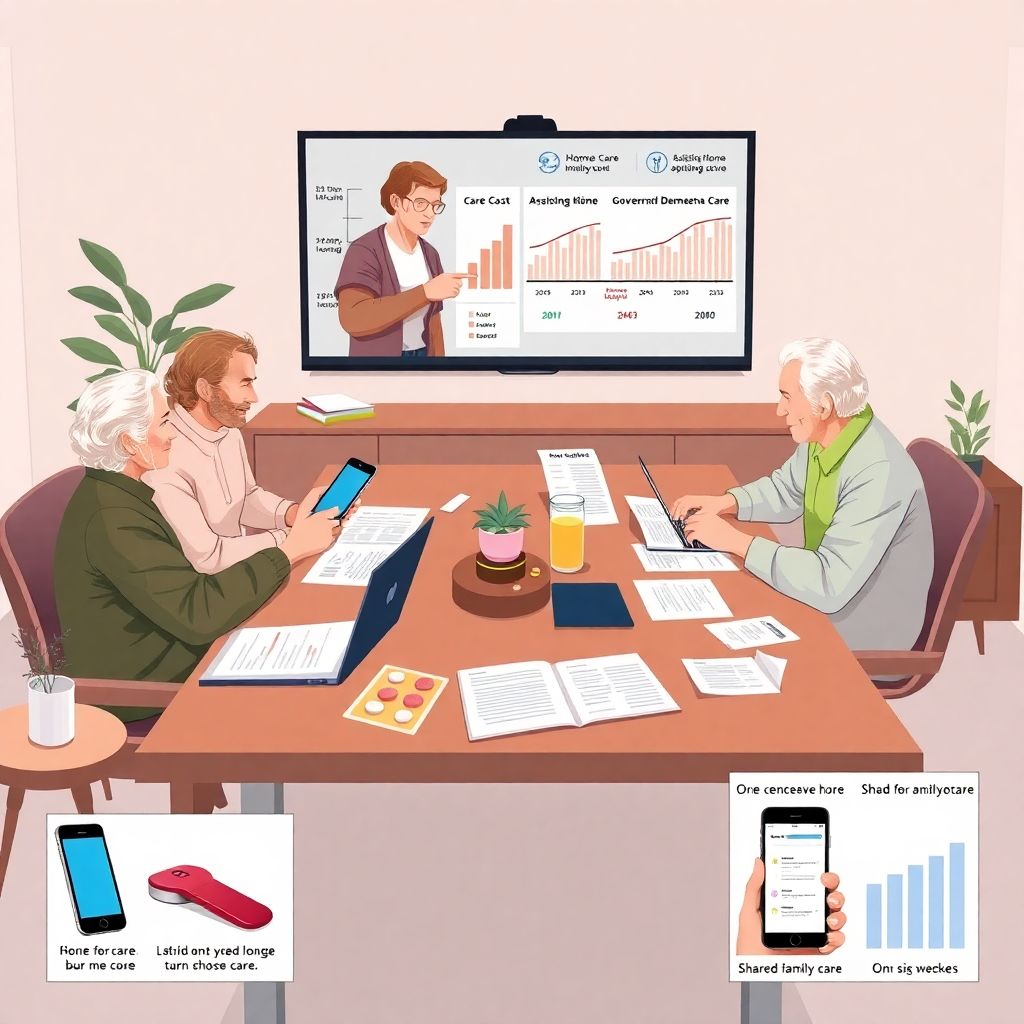Money and family are always a delicate mix, and nothing tests that quite like stepping into the role of caregiver for your parents. Financial planning for parental caregiving isn’t just about spreadsheets; it’s about protecting their dignity, your sanity, and everyone’s long‑term security. Let’s walk through how to think about it in 2025—practically, historically, and with an eye on what’s changing fast.
How We Got Here: A Short History of Paying for Aging Parents
If you go back a few generations, long-term care was mostly “done at home.” Adult children lived nearby, healthcare was simpler, and life expectancy was shorter. Financial planning was informal: the family farm, a small pension, maybe some savings, and a lot of unpaid family labor. In the mid‑20th century, Social Security and employer pensions picked up part of the burden, and nursing homes became the default option for many. By the 1980s and 1990s, long term care planning for aging parents started to become an actual industry: long‑term care insurance, specialized elder law attorneys, and geriatric care managers appeared. Fast‑forward to 2025: people live longer, chronic disease is common but more manageable, and adult children are often geographically scattered. That combination has made structured, proactive financial planning for parental caregiving not just helpful, but almost unavoidable if you want to avoid emotional and financial chaos.
Comparing the Main Financial Approaches to Parental Care
When you strip away the jargon, there are only a few core ways to fund care for aging parents: use their money, use your money, use insurance, use government benefits, or some mix of all three. The details get messy, but the core trade‑offs repeat. Relying on your parents’ savings and income gives them more control and usually feels fair, but it can be scary if their nest egg is modest and the cost of care rises faster than expected. Paying out of your pocket gives you flexibility but can quietly sabotage your own retirement. Then there’s insurance and public programs: long‑term care insurance, life insurance with living benefits, Medicare, Medicaid, and veterans’ benefits. Each has rules, waiting periods, and fine print that matter. That’s why people increasingly bring in a financial planner for aging parents and elder care, not just for investment advice but to map scenarios like, “What if Mom needs home care for three years and then assisted living?” and “What happens if Dad’s dementia progresses faster than we think?”
How to Pay for Elderly Parents’ Care: Key Building Blocks
The practical question everyone ends up asking is how to pay for elderly parents care without blowing up the entire family’s finances. The starting point is usually a brutally honest inventory: income (pensions, Social Security, annuities, rental income), assets (savings, investments, home equity), and regular expenses. Then you overlay potential care costs: home health aides, adult day care, assisted living, memory care, or skilled nursing. In 2025, more families are mixing and matching: part‑time in‑home help plus family caregiving, or periods of adult day programs to delay a move to a facility. Creative strategies might include using a reverse mortgage in a very targeted way, repositioning underused assets, or using hybrid insurance policies. The best choices depend on how stable your parents’ health is, how many children can realistically contribute time or money, and how much risk you’re willing to tolerate if things drag on for many years instead of a few.
Comparing the Cost of In‑Home Care vs Nursing Home for Parents
One of the most emotionally loaded comparisons is the cost of in home care vs nursing home for parents. On paper, home care can look cheaper at first: you might start with a few hours a week of help with bathing, meals, or medications. But as needs intensify, the hours—and the bills—grow. At high levels of need, 24/7 in‑home care can exceed the price of many nursing homes, especially in expensive metropolitan areas. Nursing homes, on the other hand, have more predictable pricing but less flexibility: you’re paying for a full set of services whether your parent uses all of them or not. When you add in “hidden” costs—family travel, time off work, and the emotional toll of caregiving—your calculations should be broader than just the hourly rate of an aide or the monthly fee of a facility. A thoughtful comparison includes quality of life, safety, social connection, and the likelihood that each option can be sustained for years, not just months.
Insurance and Other Formal Tools: What Actually Works Now
Many families only learn about long‑term care insurance when it’s too late to buy it affordably. The best long term care insurance for parents is usually purchased well before they’re frail—often in their 50s or early 60s—when premiums are still reasonable and medical underwriting is easier to pass. In 2025, classic stand‑alone long‑term care policies still exist, but hybrid policies that mix life insurance or annuities with long‑term care benefits are dominating. They’re not perfect—higher premiums and complex features are common—but they reduce the “use it or lose it” problem. Beyond insurance, you’ll see tools like health savings accounts (if your parents had high‑deductible plans earlier), immediate annuities to turn savings into predictable income, and carefully structured withdrawals from retirement accounts. The trick is coordination: without a coherent plan, you can end up paying unnecessary taxes, losing eligibility for benefits, or spending down assets too fast simply because nobody did the math across all these tools at once.
Tech Tools and Digital Care Platforms: Pros and Cons
Technology has rushed into elder care and financial planning, promising easier coordination and smarter decisions. Today you can track Mom’s blood pressure through a smartwatch, monitor medication adherence via connected pill dispensers, and use apps to share tasks and expenses among siblings. There are also digital platforms that estimate future care costs, compare local providers, and integrate with budgeting software. The upside is clear: better data, fewer surprises, and the ability to coordinate caregiving across different time zones. The downside is just as real: privacy concerns, subscription creep, overreliance on algorithms, and parents who are either unwilling or unable to use new tools. Tech doesn’t replace the need for human judgment, nor does it remove the emotional labor involved in caregiving. Instead, it changes where the stress shows up—less time chasing paperwork, more time interpreting dashboards and negotiating family expectations.
• Преимущества технологий в уходе и планировании:
– Упрощённое отслеживание расходов и счетов, включая совместные семейные бюджеты
– Дистанционный мониторинг здоровья и безопасности пожилых родителей
– Ускоренная подготовка к встречам с юристами и консультантами через автоматические отчёты
• Возможные минусы цифровых решений:
– Сложность настройки для семей без технического опыта
– Опасения по поводу конфиденциальности финансовых и медицинских данных
– Риск выбора неподходящих продуктов по рекомендации “умных” алгоритмов без человеческой проверки
Сравнение подходов: Семейное финансирование, страхование и госпрограммы
На практике финансовое планирование ухода за родителями почти всегда сводится к сочетанию трёх подходов: семейное финансирование, частное страхование и государственные программы. Семейный подход строится на том, что дети помогают деньгами или временем, иногда платя родителям «арендную плату» или беря на себя отдельные расходы вроде лекарств и такси. Страхование даёт структуру и частичную предсказуемость, но требует раннего планирования и дисциплины при оплате взносов. Государственные программы — от Medicare и Medicaid до местных субсидий и льгот — работают как сеть безопасности, но их условия и ограничения часто недооценивают. Взрослым детям полезно сравнивать эти подходы не только по стоимости, но и по тому, сколько контроля и гибкости они сохраняют, как защищают имущество семьи и насколько реалистично их поддерживать на протяжении многих лет.
Когда Нужен Специалист: Роль Финансового Плана и Консультантов

Момент, когда семья признаёт, что сама не справляется, часто приходит позже, чем следовало бы. Специализированный financial planner for aging parents and elder care помогает не только с цифрами, но и с расстановкой приоритетов. Он может построить сценарии вроде “ранний инсульт с быстрым ухудшением” или “долгая жизнь с умеренными ограничениями” и показать, при каких условиях деньги заканчиваются. Кроме того, такой специалист обычно работает в связке с юристами по вопросам престарелых, налоговыми консультантами и медико‑социальными работниками, что экономит время и снижает риск дорогостоящих ошибок. Если активы родителей или сложность их ситуации заметно выше среднего—несколько объектов недвижимости, бизнес, гражданство в другой стране—подключение профессионала почти всегда окупается уже тем, что вы избегаете хаотичных решений под давлением кризиса.
• Ситуации, когда особенно стоит привлечь специалиста:
– Родители владеют недвижимостью и спорными активами, и вы не хотите случайно лишиться льгот
– В семье несколько детей с разным уровнем дохода и взглядами на справедливое распределение затрат
– У родителей есть полисы страхования или пенсионные планы, условия которых никто толком не понимает
Как Выбрать Подход и Не Сломать Семейные Отношения
Реальные конфликты возникают не столько из‑за цифр, сколько из‑за ожиданий. Поэтому подбор финансовой стратегии должен начинаться с разговора: что для родителей важнее — остаться дома любой ценой или минимизировать нагрузку на детей? Готовы ли они использовать дом или другие активы для оплаты ухода, или хотят сохранить их в наследство? После такого разговора легче решить, какие инструменты подходят: усилить домашний уход с постепенным увеличением часов, заранее забронировать место в хорошем пансионате, докупить страхование или заключить семейное соглашение о распределении расходов. Полезно письменно оформить договорённости: кто отвечает за медицинские решения, кто за финансы, кто за повседневную координацию. Это снижает вероятность обид, когда расходы возрастают, а ресурсы истощаются быстрее, чем ожидалось, и позволяет обсуждать изменения не с нуля, а на основе заранее принятых принципов.
Тенденции 2025 Года: Что Меняется в Уходе и Финансовом Планировании

К 2025 году несколько тенденций заметно переформатировали мир финансового планирования для ухода за родителями. Во‑первых, растёт спрос на гибридные модели: часть недели родители живут дома с поддержкой, а несколько дней проводят в дневных центрах или краткосрочных пансионатах. Это меняет структуру расходов и делает расчёт «стоимости ухода» менее линейным. Во‑вторых, страховщики адаптируются: новые продукты чаще включают гибкие выплаты, опции для неформальных семейных опекунов и привязку к индексу инфляции медицинских услуг. В‑третьих, цифровые платформы анализа расходов и прогнозов здоровья становятся стандартом у профессиональных консультантов, а не экзотикой. Наконец, возрастает внимание к эмоциональному выгоранию семейных опекунов: многие планы теперь включают бюджет на respite care — временную замену, позволяющую детям‑опекунам отдыхать, не чувствуя вины. Вместе это формирует более реалистичный, комплексный подход, в котором деньги, здоровье и отношения рассматриваются не раздельно, а как связанная система.

